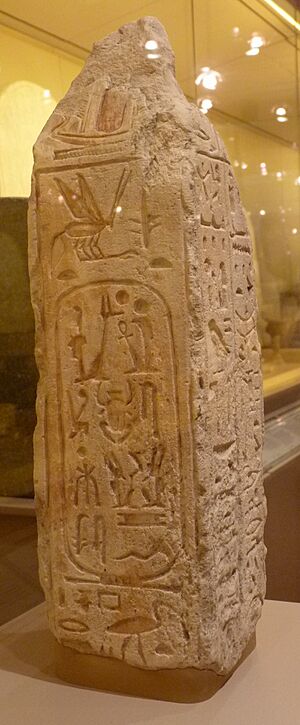Ramesses V facts for kids
Quick facts for kids Ramesses V |
|
|---|---|
| Also written Ramses and Rameses | |

Obelisk of Ramesses V. Archaeological Museum of Bologna, KS 1884
|
|
| Pharaoh | |
| Reign | 1149–1145 BC (20th Dynasty) |
| Predecessor | Ramesses IV |
| Successor | Ramesses VI |
| Consort | Henutwati and Tawerettenru |
| Father | Ramesses IV |
| Mother | Duatentopet |
| Died | 1145 BC |
| Burial | KV9; Mummy found in the KV35 royal cache (Theban Necropolis) |
Ramesses V was an ancient Egyptian pharaoh, or king, who ruled during the Twentieth Dynasty of Egypt. He was the son of Ramesses IV and Queen Duatentopet. You can see his mummy today at the National Museum of Egyptian Civilization in Cairo.
Contents
Ramesses V's Rule
During Ramesses V's time, the priests of the god Amun became very powerful. They controlled much of the land owned by temples and also managed the country's money. This meant the pharaohs had less power. A very old document called the Turin 1887 papyrus tells us about a money problem during Ramesses V's rule. It involved priests from a place called Elephantine.
Challenges in Year 1
Ramesses V's rule faced some difficulties within Egypt. A document called the Turin Papyrus Cat. 2044 shows this. It says that workers building Ramesses V's tomb, KV9, sometimes stopped working. They were afraid of "the enemy," who were likely Libyan raiders. These raiders had reached a town called Per-Nebyt and "burnt its people."
Another attack by these raiders happened in Thebes a few days later. This shows that the Egyptian government struggled to keep even its important tomb workers safe. It was a very difficult time for the country.
Land and Taxes in Year 4
The Wilbour Papyrus is a very important document from Ramesses V's fourth year as pharaoh. It was a big survey of land and how much tax people had to pay. This survey covered a large area, about 90 miles long, from near Crocodilopolis (Medinet el-Fayyum) to El-Minya.
The papyrus showed that most of Egypt's land was controlled by the temples of Amun. These temples also managed the country's money. The document also highlighted the growing power of the High Priest of Amun, Ramessesnakht. His son, Usimare'nakhte, held the important job of chief tax master.
Ramesses V's Death
We don't know exactly how Ramesses V died. However, we know he ruled for almost four full years. He passed away in his fourth year as pharaoh. This happened around the first or second month of the season called Peret.
His Burial
An ostracon (a piece of pottery used for writing) tells us something unusual. Ramesses V was not buried until the second year of his successor, Ramesses VI. This was very strange because Egyptian tradition said a king should be buried just 70 days after his successor began ruling.
One reason for this delay might have been that Ramesses VI needed to clear out Libyan invaders from Thebes. He might have also needed to prepare a temporary tomb for Ramesses V. This would allow for a double burial later in tomb KV9. A work journal from Thebes (P. Turin 1923) from Ramesses VI's second year shows that things were back to normal in the Theban West Bank by then.
Ramesses V's Mummy
The mummy of Ramesses V was found in 1898 by Victor Loret in a tomb called KV35. In 1905, G.E. Smith unwrapped and studied the mummy. He found that the body showed signs of disease. Smith described Ramesses V as a young man. Experts Ikram and Dodson believe he died in his early thirties.
Smallpox Theory
One idea is that Ramesses V might have gotten sick and died from smallpox. This is because marks, or lesions, were found on his face. If this is true, he would be one of the earliest known people to have suffered from this disease.
Bubonic Plague Theory
Another idea is that he might have had swellings in his groin area. These are often linked to the bubonic plague.

